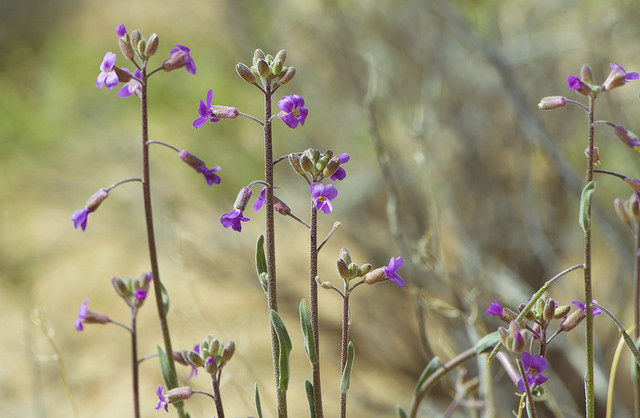 Plant Biology
Plant Biology
Boechera, Why are you so Cool?
Due to their static nature, plants must adapt to their surrounding environment. Among other challenges, resisting to the sun-heat is a major one. How do they cope with that?

Kipling once said: "Only mad-dogs and Englishmen go out in the noon day sun". To this list we can also add plants they are out in the noon day sun because they are not able to move to the shade when things get hot. Plants must survive, grow, and reproduce, wherever their seed germinates.
We have long known that high temperatures, for instance, a heat wave of 32 °C or higher, can disrupt how plants get their food (photosynthesis) and how they make baby plants (pollination). The impact of heat stress on plants can be seen in reductions in crop yield in agricultural fields during hot summers. But heat stress is also a big problem for wild or native plants. As our climate warms heat waves have become more intense. Each year we are recording more and more record highs. Heat waves are not just getting hotter they are also lasting longer, weeks instead of days. All of this is very stressful for plants and could drive many of our native species to extinction.
This research project was motivated by a few simple questions: How do plants respond to heat stress in nature? Have some plants figured out how to survive heat waves? And if so will this information useful in making crop species more tolerant to heat waves?
The goal of this research was to examine a group of native California mustard plants that live in different habitats and understand how they respond to heat stress. Seeds were collected from natural populations of different species of California mustards in the Boechera genus. We collected seeds from plants that live in the Mojave and Anza Borrego deserts, plants that live in coastal chaparral regions, and plants that live at high mountain tops in the Sierra Nevada Mountains. We grew the plants in our lab and exposed them to temperatures from 38 °C (100 °F) up to 47 °C (117 °F). All of the Boechera plants were able to tolerate heat above 38 °C. But what was both surprising and exciting was that we discovered that some of the native California mustards are perfectly happy at temperatures as high as 47 °C.
The species that is the most tolerant to heat did not come from the deserts, as we had predicted before the start of the experiment, but in fact had been collected from a very high mountain top in the Sierra Nevada Mountains. This plant (B. depauperata) is able to continue making its own food (photosynthesizing) after hours at 47 °C. It can also repair cellular damage it experiences at these high temperatures.
"Heat Shock" is how all organisms respond to high temperature stress. The Heat Shock Proteins have been called "The Paramedics of the Cell" because they can repair heat-induced cellular damage. We had expected that high levels of these proteins in Boechera could explain why it is able to withstand the heat. But when we looked to see if this species (Boechera depauperata) was protecting itself with Heat Shock Proteins we found that this is not the case. It appears that Boechera is not bothered by the heat and does not need the paramedics of the cell to avoid death.
How does Boechera stay so cool? All good scientific studies answer one question and raise ten more. We now have no shortage of new questions to ask about how Boechera stays cool. Does it have to do with extra sets of chromosomes? Are their leaves better at cooling off or sweating using their pores or stomates. Answers to these questions could help us keep all plants cool as the world gets hotter.
Our research on Boechera was funded by a grant from the National Science Foundation to Prof. Elizabeth R. Waters at San Diego State University. She is currently applying for more grants to continue her work on these amazing plants.
All science involves team work. Our Boechera team included Gillian Halter, a graduate student at SDSU. Both Nicole Simonetti and Cristy Suguitan were undergraduates at SDSU. Our team also included Jessica Soroksky an undergraduate at Sienna College and Ken Helm, a Professor at Sienna College. The seeds for Boechera depauperata were collected by Dr. Alison Colwell.
Original Article:
Halter G, Simonetti N, Suguitan C, Helm K, Soroksky J, Waters E. Patterns of thermotolerance, chlorophyll fluorescence, and heat shock gene expression vary among four Boechera species and Arabidopsis thaliana. Botany. 2017;95(1):9-27. doi:10.1139/cjb-2016-0158.Next read: Nitrogen pollution from lowlands reaches distant mountain lakes by Beth Hundey , Katrina Moser , Fred Longstaffe
Edited by:
Massimo Caine , Founder and Director
We thought you might like
Why some forests burn better than others
May 19, 2015 in Earth & Space | 4 min read by Elisa Dell'AglioTara Oceans Expedition sequences the ocean
Nov 24, 2015 in Earth & Space | 4 min read by Chris BowlerOcean acidification and its effects on coral reef growth
Jul 8, 2016 in Earth & Space | 3.5 min read by Rebecca AlbrightResetting nature’s clock: shifting seasons and species relationships
Sep 14, 2016 in Earth & Space | 3.5 min read by Stephen Thackeray , Sarah BurtheMore from Plant Biology
Unravelling the Secrets of Pine Roots: A Tale of Nutrition and Adaptation
Oct 20, 2023 in Plant Biology | 3.5 min read by Rafael Cañas , Francisco OrtigosaStressful memories help plants resist caterpillars
Oct 2, 2023 in Plant Biology | 3.5 min read by Samuel Wilkinson , Adam Hannan Parker , Jurriaan TonDecoding the genome of a jackfruit that grows all year round
Sep 6, 2023 in Plant Biology | 3.5 min read by Tofazzal IslamLife after logging: the tale of recovering tropical forests
Aug 21, 2023 in Plant Biology | 3.5 min read by Maria Mills , Terhi RiuttaEditor's picks
Trending now
Popular topics


